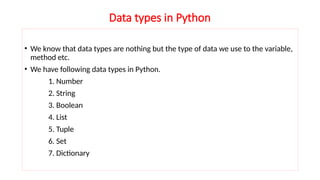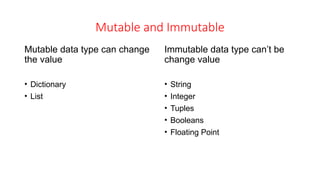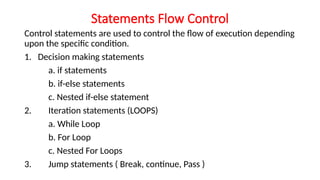Python Revision Tour.pptx class 12 python notes
- 2. Introduction Python revision Tour- 1 • Introduction to Python • Working with Python • Data types , Operations • Python Functions, Modules • Flow of execution • Statement flow control Python revision Tour- 2 • Sting in python • List in python • Tuple in python • Dictionary in python
- 3. Python used as general purpose, high level programming language. Developed by Guido van Rossum in 1991. Pros of Python : • Easy to use – Due to simple syntax rule • Interpreted language – Code execution & interpretation line by line • Cross-platform language – It can run on windows, Linux, Macintosh etc. equally • Expressive language – Less code to be written as it itself express the purpose of the code. • Completeness – Support wide rage of library • Free & Open Source – Can be downloaded freely and source code can be modify for improvement
- 4. Cons of Python • Lesser libraries – as compared to other programming languages like C++, java, .NET • Slow language – as it is interpreted languages, it executes the program slowly. • Weak on Type-binding – It not pin point on use of a single variable for different data type
- 5. Data types in Python • We know that data types are nothing but the type of data we use to the variable, method etc. • We have following data types in Python. 1. Number 2. String 3. Boolean 4. List 5. Tuple 6. Set 7. Dictionary
- 6. Number In Python we use number data type to store numeric value. • Integer – Whole number without fraction parts ex: 1, 2 etc. Use 32 bits to store value. • Long integer – It store larger integer number. Use 32 bits to store value. • Floating Point – It is a positive or negative real numbers with a decimal point. • Complex – Complex numbers are combination of a real and imaginary part. Complex numbers are in the form of X+Yj, where X is a real part and Y is imaginary part. Input : a = complex(5) Output : (5+0j) print(a)
- 7. String • A string is a sequence of characters. In python we can create string using single (' ') or double quotes (" ").Both are same in python. Ex : - Input : str='computer science’ print('str-', str) # print string Output : str- computer science
- 8. String Method Method Description Capitalize() Returns a copy of string with its first character as capita Find() Returns the lowest index in the string Isalnum() Returns true if the character in the string are alphanumeric Isalpha() Returns true if the character in the string are alphabetic Isdigit() Returns true if the character in the string are digit Islower() Returns true if all the cased characters in the string are lowercase Isupper() Returns true if all the cased characters in the string are uppercase Title() Returns True if the string is in title case Swapcase() Returns a copy of the string with uppercase character converted to lowercase and vice versa Partition() Splits the string at the first occurrence of argument
- 9. String Methods contd.. Method Description Isspace() Returns true if there are only whitespace character in the string Count() Returns the number of non-overlapping occurrence of substring in the given string lstrip Returns a copy of the string with leading characters removed rstrip Returns a copy of the string with trailing characters removed Startswith() Returns true if string starts with the argument otherwise return false Endswith() Returns true if string ends with the argument otherwise return false Lower() Returns a copy of string converted to lowercase Upper() Returns a copy of string converted to uppercase Title() Returns a titlecase version of the string
- 10. Boolean It is used to store two possible values either true or false. e.g. a=“jnv" b=str.isupper() # test if string contains upper case print(b) Output : False LIST List are collections of items and each item has its own index value.
- 11. List Methods Method Description Index() Returns the index of first matched item from the list Append() Adds an item to the end of the list Extend() Adds list at the end Insert() Insert any item in between the list Pop() Remove an item from the list Remove() Remove the first occurrence of the given element Clear() Remove all the items from the list Count() Returns the count of the item that passes as argument Reverse() Reverses the item of the list Sort() Sort the item of the list, by default in increasing order
- 12. Tuples • Tuples are list of value separated by comma ( , ). • Tuples are Immutable which means values in the tuple can not be changed. • The data type in tuple can be any. Which means we can have number and string in same tuple. • Tuple is represented as : ( ) Example: 1) t1 = (1,2,3,4,5,6) 2) t2 = (‘A’ , ‘B’ , ‘C’) 3) t3 = (‘a’ , ‘b’ , 1,2,3,4,5,6)
- 13. Tuple Methods Method Description Len() Return the length of tuple Max() Returns the element from the tuple having maximum value Min() Returns the element from the tuple having minimum value Index() Returns the index of an existing element of a tuple Count() Returns the count of the member element / object in a given sequence( list/tuple) Tuple() Constructor method, create tuple
- 14. Dictionary • It is an unordered collection of items and each item consist of a key and a value. e.g. dict = {'Subject': 'comp sc', 'class': '11’} print(dict) print ("Subject : ", dict['Subject’]) print ("class : ", dict.get('class’)) Output {'Subject': 'comp sc', 'class': '11’} Subject : comp sc class : 11 class : 11
- 15. Dictionary Method Method Description len() Returns length of the dictionary clear() Remove all method from the dictionary get() Get the item with the given key has_keys To check the presence of given key in the dictionary items() Return all the items of the dictionary key() Return all the keys in the dictionary value() Returns all the values from the dictionary in the form of list in no particular order update() This will merge the key : value pairs from a new dictionary, adding or replacing as needed cmp Compare to dictionary based on their elements
- 16. List • A list in python is represented by square bracket []. • List is assigned to Variable • The value inside a list can be changed. example : (1) a = [1,2,3,4,5] (2) b = [‘A’ , ‘B’ , ‘C’] (3) c = [1,2, ’A’ , ‘B’ ]
- 17. Mutable and Immutable Mutable data type can change the value • Dictionary • List Immutable data type can’t be change value • String • Integer • Tuples • Booleans • Floating Point
- 18. Arithmetic Operators Operators are special symbols in Python that carry out arithmetic or logical computation. The value that the operator operates on is called the operand. Arithmetic operators Used for mathematical operation Operator Meaning Example + Add two operands x + y +2 - Subtract right operand from the left x - y -2 * Multiply two operands x * y / Divide left operand by the right one x / y % Modulus - remainder of the division x % y // Floor division - division that results into whole number x // y ** Exponent - left operand raised to the power of right x**y
- 19. Comparison operators- Used to compare values Operator Meaning Example > Greater than - True if x is greater than y x > y < Less that - True if x is less than y x < y == Equal to - True if both operands are equal x == y != Not equal to - True if operands are not equal x != y >= Greater than or equal to - True if left operand is greater than or equal to the right x >= y <= Less than or equal to - True if left operand is less than or equal to the right x <= y
- 20. Logical Operator Operator Meaning Example and True if both the operands are true x and y or True if either of the operands is true x or y not True if operand is false not x
- 21. Operators Precedence Operator~ + - Description ** Exponentiation (raise to the power) ~ + - Complement, unary plus and minus (method names for the last two are +@ and -@) * / % // Multiply, divide, modulo and floor division + - Addition and subtraction >> << Right and left bitwise shift & Bitwise 'AND' ^ | Bitwise exclusive `OR' and regular `OR' <= < > >= Comparison operators <> == != Equality operators = %= /= //= -= += *= **= Assignment operators is is not Identity operators in not in Membership operators not or and Logical operators
- 22. Python Function and Module Python function : • Function in Python are self controlled piece of program which perform a specific task. • We can use in program whenever needed by invoking them. • Categories of python function: 1. Build in unction 2. Function defined in module 3. User defined function. Python Module : • It is a python file. • It’s extension is .py • Can be re-used in other programs • Can depend on other module • Independent of grouping of code and data
- 23. Statements Flow Control Control statements are used to control the flow of execution depending upon the specific condition. 1. Decision making statements a. if statements b. if-else statements c. Nested if-else statement 2. Iteration statements (LOOPS) a. While Loop b. For Loop c. Nested For Loops 3. Jump statements ( Break, continue, Pass )
- 24. If Statements An if statement is a programming conditional statement that, if proved true, performs a function or displays information. Input Output x=1 y=2 if(x==1 and y==2): print(‘Matched') Matched
- 25. if-else Statements • If-else statement executes some code if the test expression is true and some other code if the test expression is false. Input Output a=10 if(a < 100): print(‘less than 100') else: print(‘more than equal 100') less than 100
- 26. Nested if-else statement The nested if...else statement allows you to check for multiple test expressions and execute different codes for more than two conditions. Input Output num = float(input("Enter a number: ")) if num >= 0: if num == 0: print("Zero") else: print("Positive number") else: print("Negative number") Enter a number: 4 Positive number
- 27. Iteration Statements (Loops) While Loop It is used to execute a block of statement as long as a given condition is true. And when the condition become false, the control will come out of the loop. The condition is checked every time at the beginning of the loop. While – else It is used to execute a block of statement as long as a given condition is true. And when the condition become false, it execute else part of block of statements and come out of the loop. Input (While ) Output x = 1 while (x <= 4): print(x) x = x + 1 1 2 3 4 Input (While-else) Output i = 0 while i < 4: i += 1 print(i) else: print("Breakn") 1 2 3 4 Break
- 28. For Loop • It is used to iterate over items of any sequence, such as a list or a string. • e.g. • for i in range(3,5): • print(i) • Output • 3 • 4
- 29. Continue Statement: It returns the control to the beginning of the loop Break Statement: It brings control out of the loop. Pass Statement: We use pass statement to write empty loops. Pass is also used for empty control statements, function and classes. Input Output for letter in ‘rajeev': if letter == 'e' or letter == ‘a': continue print( letter) r J v Input Output for letter in 'rajeev': if letter == 'a' or letter == 'j': break print('Current Letter :', letter) Current Letter : a for letter in 'rajeev': pass print('Last Letter :', letter) Last Letter : v













![Dictionary
• It is an unordered collection of items and each item consist of a key and a value.
e.g. dict = {'Subject': 'comp sc', 'class': '11’}
print(dict)
print ("Subject : ", dict['Subject’])
print ("class : ", dict.get('class’))
Output
{'Subject': 'comp sc', 'class': '11’}
Subject : comp sc class : 11
class : 11](https://image.slidesharecdn.com/pythonrevisiontour-241014130323-97efe00c/85/Python-Revision-Tour-pptx-class-12-python-notes-14-320.jpg)

![List
• A list in python is represented by square bracket [].
• List is assigned to Variable
• The value inside a list can be changed.
example : (1) a = [1,2,3,4,5]
(2) b = [‘A’ , ‘B’ , ‘C’]
(3) c = [1,2, ’A’ , ‘B’ ]](https://image.slidesharecdn.com/pythonrevisiontour-241014130323-97efe00c/85/Python-Revision-Tour-pptx-class-12-python-notes-16-320.jpg)












